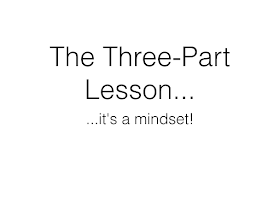"Test mystique", to use Bennett, Dworet, and Weber's (2008) term, is persistent and pervasive in our dealings with our students, as tests are sometimes seen to have a "mystical capacity to open a window into a student's inner being and the workings of his or her mind".
Some teachers are reluctant to trust their own informed judgements and classroom assessments, deferring instead to testing results, many of them standardized, for the "final word" about the strengths and needs of their own students. As the authors note, teachers will often "defer to test results even when those results contradict their own observations and conclusions arrived at over months of on-site observations and analyses".
I believe this is wrong. We need to trust our eyes and ears, most of all. When I stopped giving math tests, I felt I only knew my students better. That said, short quizzes and tests are appropriate in some circumstances- I liked them as "checking in" on basic skills- for example, can you add and subtract integers correctly?
Wiggins and McTighe (1998), note that using tests as the mark and measure of student achievement is a "long-standing habit". Test mystique still prevails-perhaps in math classrooms more than any other subject.
Here are some assessment principles that I think are effective and fruitful for the mathematics classroom.
1. Engage students in purposeful talk about what they are learning as they work on a classroom task. Walking and talking is assessment. Record and use tracking sheets with anecdotes from this purposeful talk, and treat it as valuable data, part of the bigger picture of how and what the student is learning.
2. Don't be afraid to not give a test. Tomlinson (2008) talks of her early years, when she only knew she was "supposed to give tests and grades", although she didn't like them.
3. Find a system to document observations and anecdotes from conversations. It is often hard to stop in the "flow" and write things down, but techniques like using checklists will help. I have experimented with using tape recorders (old school), and now apps, to record observations, as my handwriting is rather difficult to read. Remember the power of the camera roll- take pictures of work in progress frequently.
4. Use frequent checkpoints in larger assignments. This relates to the concept of chunking-allow students to check-in frequently in their learning. Give students checklists which will aid in task completion. If, for example, a student is building an electric car in Science class, give dates to bring materials, dates to complete sketches, and detailed lists of how the task is to be completed. In the math classroom, allow students to check in as they work on longer problems or assessments. Help their thinking develop.
5. Give frequent feedback to improve student learning. A state of helplessness often sets in when an exceptional student does not know if he or she is doing the work "right"; feedback helps to redirect a student positively, and giving feedback helps bring a task closer to completion. I have read, and refer to quite frequently, the work of Black and William (1998) on feedback for learning. It is quite a long work, but boils down to simply this: feedback works! One single piece of directed feedback is sometimes all it takes!
6. Trust your own judgement!
Bennett, Dworet, and Weber's (2008). https://www.amazon.ca/Special-Education-in-Ontario-Schools/dp/0986587311
Carol Tomlinson's Books: https://www.amazon.com/s?ie=UTF8&page=1&rh=n%3A283155%2Cp_27%3ACarol%20Ann%20Tomlinson
Wiggins and McTighe: http://www.ascd.org/Publications/Books/Overview/Understanding-by-Design-Expanded-2nd-Edition.aspx
Black and William article: http://www.tandfonline.com/doi/pdf/10.1080/0969595980050102


















